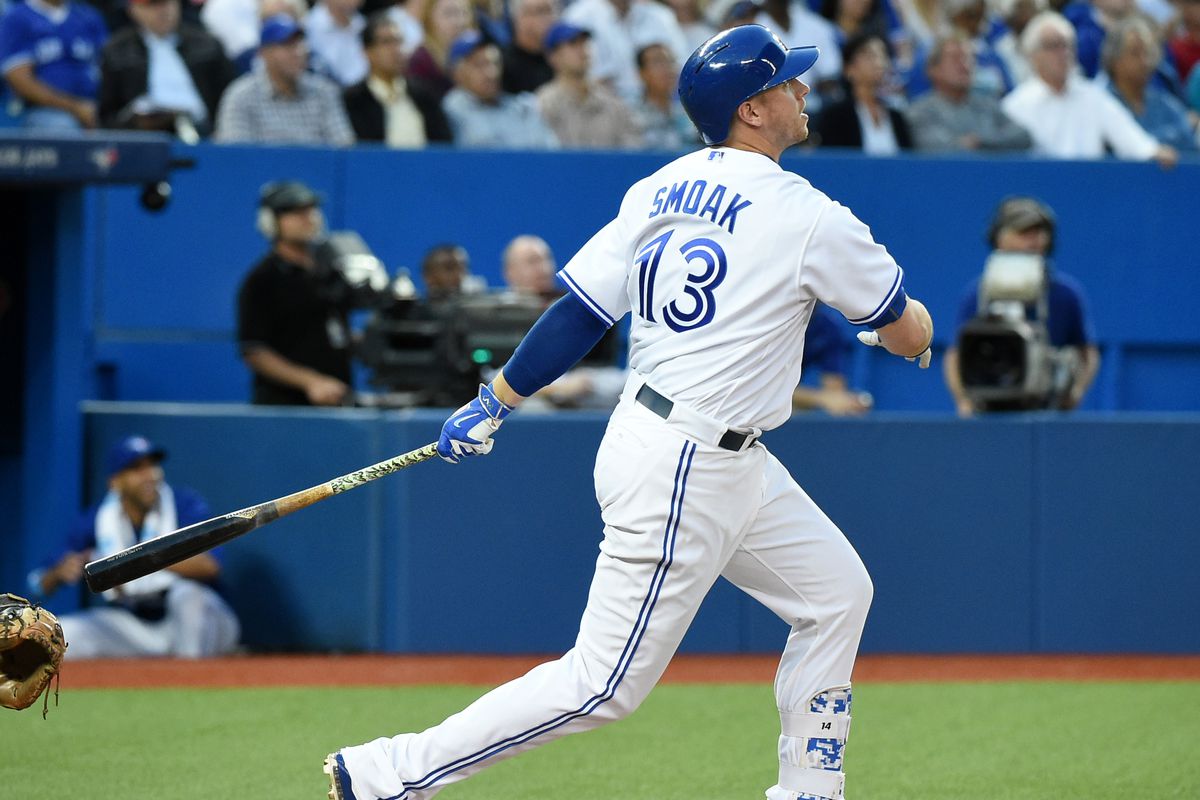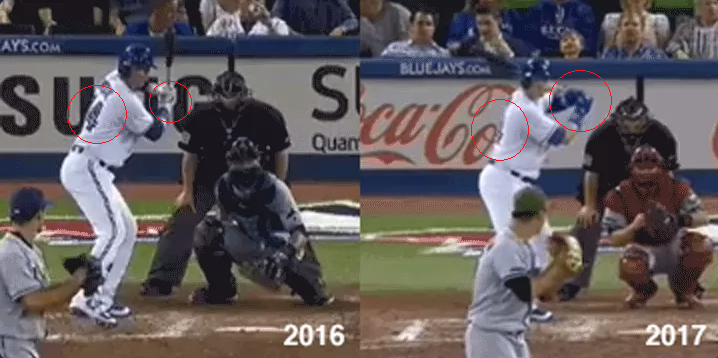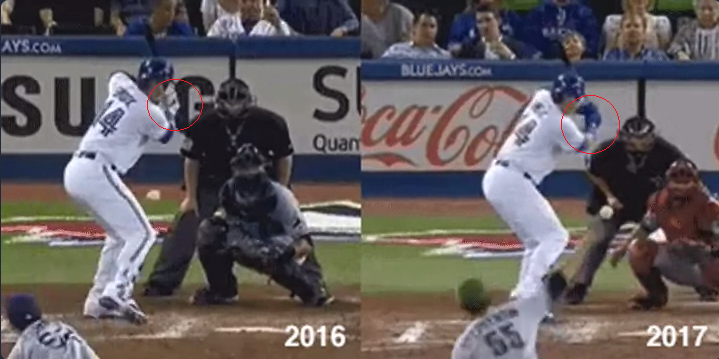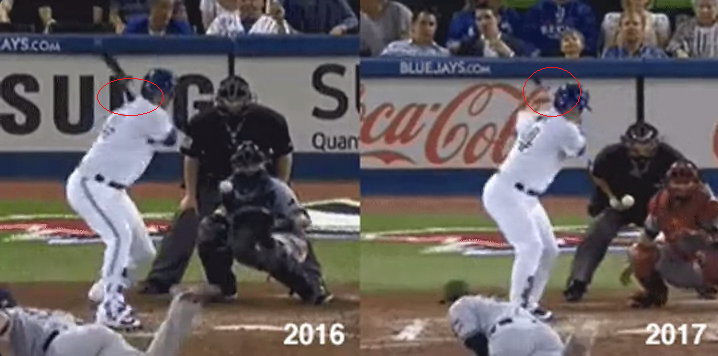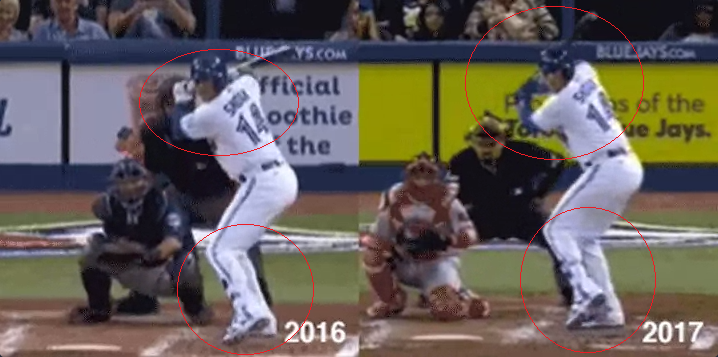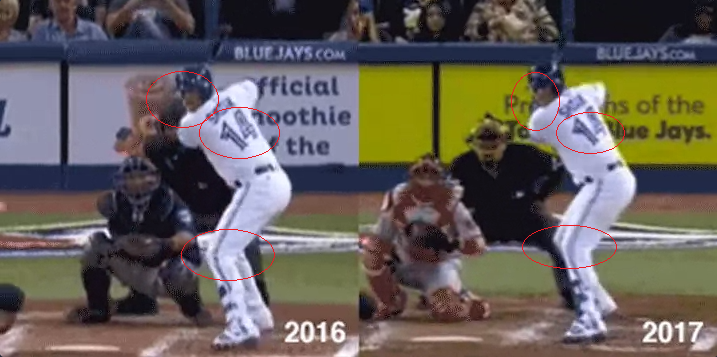Justin Smoak has always been an odd player, but this year he’s been downright baffling.
In his post on the 2010 Rangers Top 11 prospects, Kevin Goldstein noted that, “[Justin Smoak] has the best plate discipline in the organization, and among the best in baseball, with plus raw power from both sides.” Yet up until 2016, through the major and minor leagues, he’d hit home runs in just 3.4 percent of his plate appearances. For reference, the major league average home run rate in 2017 is 3.3 percent.
In 2017, we’ve seen a different Smoak: One who has blasted by his career high of 20 homers in a season in only 374 plate appearances. One who is posting his first ever batting average above .240—he’s above .300 for the time being. One who is 16th in the league in true average, with a lofty .326—36 points above a certain Dominican man with a parrot. Yet, this isn’t some fluky success that we can dismiss with BABIP and HR/FB%. Justin Smoak’s current BABIP is .313, above his career .265, but not too far above his 2016 mark of .295 and within the realm of consistent possibility. Similarly, his current HR/FB% is 24.3%, which is well above his career average of 14.8%, but within the realm of what a hitter with Smoak’s exit velocity totals could reach and not too far from his two year average of 21.5%. In other words, he’s not Chris Colabello.
Based solely on his plate discipline stats (O-Swing%, Z-Swing%, Swing%, O-Contact%, Z-Contact%, Contact%), 2016 Justin Smoak’s top five comps were 2013 Jason Kubel, 2008 Ian Stewart, 2008 Ryan Ludwick, and 2013 Colby Rasmus; five of baseball’s most swing happy players in the last decade. Meanwhile, 2017 Justin Smoak’s top five comps are 2013 Carlos Beltran, 2015 Kyle Seager, 2014 Aaron Hill, 2013 Neil Walker, and 2008 Stephen Drew. While none of the latter set of players are about to walk more times than they strike out, those are five respectable hitting seasons.
In a post at FanGraphs in early June, Jeff Sullivan looked further and found that our other traditional markers to explain changes in hitting success weren’t applicable here either, noting that, “[Justin Smoak] hasn’t overhauled his swing, and he hasn’t meaningfully adjusted his average exit velocity or launch angle. Counter to the greater trend, Smoak now is actually hitting fewer balls in the air. Smoak’s contact quality is fine.” Instead, as Sullivan bluntly puts it, “he’s just making more contact.”‘
For the most part, Sullivan is correct here, and that makes Justin Smoak’s 2017 even more perplexing. In general, a hitter’s contract rate fluctuates, but large swings are rare. Between 2016 and 2017 Smoak’s contact rate has shifted 8.9% and that’s the largest single season increase ever.
While Smoak’s 2017 season is clearly an outlier, as a whole, big changes in contact rate are fairly predictive. The contact rate of a player that’s seen a large increase or decrease has an 84% correlation with that player’s average contact rate in the three seasons that follow. This is because unlike home run rate or average, contact rate is a skill, not a result; it can be shifted, but it’s fundamentally based on the combination of a player’s raw ability and how that raw ability is applied through a player’s swing.
Jeff Sullivan is right in that the increase in contact rate is the main driver of Smoak’s newfound success. He’s also right that Smoak hasn’t overhauled his swing path. Justin Smoak did, however, make changes to the start of his swing process and the result has been a substantially more compact stroke, giving him more time to recognize good pitches and resulting in a higher contact rate.
I asked fellow BP Toronto writer and baseball mechanics aficionado Joshua Howsam to break down the specifics.
For reference, this is Justin Smoak’s swing from the left hand side in 2016 and 2017.

And this is his swing from the right hand side.

At first glance, there doesn’t appear to be too much change. He hasn’t added a leg kick nor is he setting up differently. However, Joshua Howsam has found a few key differences that look to be giving Smoak a little bit of extra time to determine whether or not to swing. The quoted comments below are his.
“From the left side, we can see that Smoak has started with a more open, upright stance while keeping his hands higher and slightly farther away from his body.”
“While he closes his body up quickly once he finishes his stride, he is still slightly more open than last year and more importantly, his hands stay higher and further away from his body than they were in 2016.”
“These changes really start to matter as he begins his swing. Right before going forward, his hands are now much higher and closer to the plate than they were in 2017. You can see the angle of the bat in the 2016 frame, which seems to be coming out of his upper back or neck, whereas in 2017 the bat is coming from behind the back of his head and you can clearly see his right hand. This creates a shorter, and thus quicker, bat path to the plate which allows Smoak to wait a little bit longer before swinging. That extra bit of time helps tremendously with the ability to make contact, as the hitter can now better perceive the trajectory of the pitch.”
“While swinging from the right side, Smoak’s hand position relative to his body is actually almost unchanged from 2016 once he gets moving. But what has changed are when he starts moving and where his body ends up when he is finished. When you watch the GIF, you can see that Smoak is starting his leg kick much earlier, which is changing up his timing and getting his hands moving much quicker (this is a big part of what turned Jose Bautista into a good hitter).”
“Then when he finishes up, Smoak’s body position is completely flipped from 2016. Last year, Smoak would start off slightly open, then close up following his stride. This year, he is starting slightly closed and then landing open. So while the hands are still the same distance from the body when he starts his swing, because his body is more open, they are taking a shorter path to the zone. The change in the leg kick timing and getting his hands moving quicker combined with the slightly shorter bat path from the open stance would give Smoak more time to recognize pitches and make consistent contact.”
Within the past few years, we’ve seen other examples of strong hitters converting to a more compact approach and finding more contact success. The Dodgers’ Joc Pederson and Astros’ George Springer are two prime examples. Both were heralded as top hitters in the minors and they had the numbers to match. Once they reached the majors, however, they had a lot of trouble getting to good breaking pitches with their longer swings. Both hitters started out their major league careers with two straight seasons of sub-70% contact rates and both saw 5% plus year over year increases.
In terms of a swing change, Joc Pederson is the more extreme example of the two. Pederson famously utilized five distinct swings throughout 2015, with the last being the one that he has carried in to the two following seasons. In November 2015, MLB Network broke down the changes.
This is all to say that Justin Smoak’s extreme success is still an outlier, but it follows a strong trend and there are other prime examples of continued success following changes. As we discussed at the beginning of the post, the raw skills have always been there, Smoak has just finally found a way to apply them. Will Toronto continue to be the place that he gets to apply them? Maybe, maybe not. But wherever he is, he’ll be smoking baseballs and scooping throws with the best of them.
Lead Photo: Dan Hamilton-USA TODAY Sports
